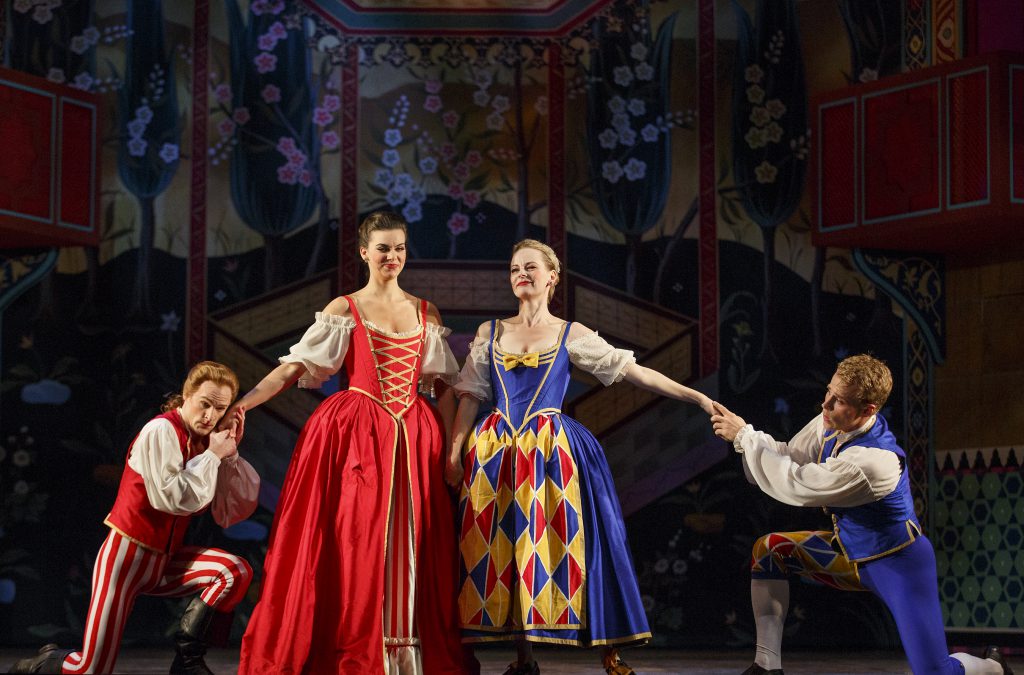Mozart had had enough. Hometown Salzburg had become a suffocating backwater for the ambitious ex-prodigy. Life as an obscure kappelmeister felt like a prison, he complained in letters and Wolfgang Amadeus Theophilus was determined to stage a daring escape.
In 1777, he resigned his provincial post and took to the open road, writing and performing, surviving by his wits. Four years later, he fetched up in Vienna. His timing was ideal. The Emperor Joseph II had recently founded a new theatre, the Nationalsingspiel, to promote comic light opera written in German in native half-spoken, half-sung style. Company director Gottlieb Stephanie hired the gifted young job-seeker from Salzburg virtually on the spot. Mozart was handed an unfinished libretto, a rowdy tale of kidnapped damsels and dashing rescuers set in a fashionably exotic Turkish locale. Four months later, he delivered a completed score, including his own added story touches. In July, 1782, Die Entführung aus dem Serail (“The Abduction from the Seraglio”) made its premiere. The rollicking extravaganza was an instant sensation. Stephanie made a fortune. Mozart, still mostly penniless after agreeing to a modest flat rate for his services, nevertheless made his reputation. His opera career had exploded into popular stardom practically overnight.
Opera Atelier, Toronto’s acclaimed early opera pioneer, reprises its 2008 production of Mozart’s rambunctious work with a lavish presentation currently on view at the Elgin Theatre. Guided by historically informed performance, director Marshall Pynkoski whisks his youthful, athletic cast through the frenzied twists and turns of the flamboyant madcap story.
A kidnapping is in progress off the Turkish coast. A noblewoman and her maid, Konstanze and Blonde, accompanied by the hapless serving girl’s suitor, Pedrillo, are plucked from the deck of their British sailing ship by pirate Pasha Selim and his cohorts.
Time passes. Belmonte, Konstanze’s fiancé, arrives at Selim’s palace in frantic search of his precious bride-to-be. There he encounters Osmin, overseer of the Pasha’s harem. Osmin lumbers off, barring the young count’s way. Just then Pedrillo happens by, much to Belmonte’s joy. His happiness at seeing his long-lost servant is short-lived. Pedrillo reveals that the Pasha has made Konstanze his wife and, if that were not bad enough, has betrothed Blonde to Osmin. Belmonte and Pedrillo creep off to hatch a scheme to rescue their true loves.
Amidst much pomp and circumstance, Pasha Selim makes a majestic entrance trailed by the newest member of his seraglio. Konstanze rebuffs the Pasha’s advances. Her heart will forever belong to another she declares before tersely excusing herself. Pedrillo enters with his former master whom he introduces as a visiting architect. Selim is intrigued and agrees to allow Belmonte, the imposter, to enter his service.
Elsewhere in the palace, Blonde spurns Osmin’s persistent wooing. An English girl like her, she sniffs, will never be his slave. Osmin storms off in a rage. Konstanze enters, tearful at her separation from her beloved Belmonte and fearful of Selim’s growing impatience with her refusal to consummate their forced marriage. A hideous bout of torture awaits her if she does not surrender to his will, warns the Pasha.
No sooner have she and Selim gone their separate ways when Pedrillo appears. He informs Blonde that the escape plot is in place. He and Belmonte will whisk the two girls away at midnight to a waiting ship after Pedrillo has plied Osmin with wine. It takes some considerable persuasion to convince the burly sentinel to sample a drink forbidden by his religion, but the tastiness of a potent Cyprian vintage prevails. Osmin falls into a drunken stupor.
Later that night in the palace garden, Belmonte and Pedrillo, equipped with a ladder, succeed in abducting Konstanze and are about to free Blonde when suddenly Osmin, freshly revived, catches them in the act. Pasha Selim bursts onto the scene. Both couples are to be clapped into prison, he commands. But fate has other plans. Belmonte’s aristocratic father, it turns out, is Pasha Selim’s oldest, most despised enemy. Rather than enacting bitter revenge, the Pasha vows to demonstrate his superior civility and nobleness by freeing all four prisoners. Belmonte and Konstanze, Pedrillo and Blonde all sing Pasha Selim’s praises as they make ready to sail for home.
The stock characters and plots of commedia dell’arte were an essential part of German singspiel. Lovers thwarted from the course of wedded bliss by a rapacious villain, domestics besting their masters, both classic situations and both raw material for Mozart’s purpose. Abduction from the Seraglio fits solidly atop eighteenth century convention. Opera Atelier’s production is no less mindful of its roots. Costume designer Margaret Lamb’s creations provide clear clues to the behaviour of the opera’s principal players even before they have hit their marks on stage. The bold diamond pattern worn by Pedrillo and Blonde announce the presence of Arlecchino and Columbina clowns. Konstanze’s fine red silk gown and Belmonte’s matching manly apparel speak of innomarati, a high-born couple destined to be together.
But there is a problem. The extreme comic exaggeration needed to power Opera Atelier’s overtly dell’arte period approach is taken several leaps beyond excessive. Parody approaches vaudevillian proportions. The quest for the next big laugh is positively obsessive and frequently out of place. Konstanze literally wrings her tears from a whopping wet handkerchief. Funny, yes, but it calls into question the legitimacy of what immediately follows, her touching lament, Traurigkeit ward mir zum Lose (“Unhappiness has become my lot”). Ironic caricature? Genuine sadness? Difficult to know how to read the prevailing emotional tone given the ambiguous direction. The same can be said about Pynkoski’s handling of countless other moments in Mozart’s amply nuanced work.
Abduction from the Seraglio is about so much more than sight gags and slapstick. Mozart pushed the singspiel form far beyond anything that had been seen on stage in his day, creating a unique depth and breadth of expression. Anguish happily co-exists with hilarity in his buffa vision, each sentiment leaning on the other. We laugh, we cry, we cheer, often at the same time. The opera is a journey through innocence to ordeal and on into maturity. Like all Mozart comedies, it ends with forgiveness and understanding. The tenderness that draws us to Mozart’s genius is largely lacking in this telling of what is at its core a profoundly compassionate tale about the meaning of being human.
Fortunately, musical happenings in this Abduction from the Seraglio are a good deal more rounded. Solos are commanding. Ensembles, always exciting and innovative in any Mozart score, are luscious. Singers are gifted with generous-sized opportunities to impress here. Opera Atelier’s talented cast does a fine job of realizing the opera’s soaring vocal potential.
Singing the role of Belmonte, tenor Lawrence Wiliford bares his heart and soul. Honest and unaffected in style, ringing and exhilarating in tone, Wiliford is a wonder. From the very first notes of Mozart’s opening Act I aria, Hier soll ich dich denn sehen (“Here I shall see you again”), a cry of suffering and loss, Wiliford takes control. His clarity and intensity are overarching, his tunefulness unsurpassed.
First lead soprano Ambur Braid is a brave, unbreakable Konstanze with a paradoxically soft, sentimental side, ever the perfect ingénue. It is Konstanze who must meet and conquer the challenge of the opera’s most famous aria, Martern aller Arten (“Tortures of all kinds”). Braid’s climb to the upper reaches of her coloratura is thrilling, her sound, once arrived at the summit, exalted. This is a singer graced with a powerful, uplifting sound. Dialing down her output results in lovely, weightless pianissimos.
Second lead tenor Adam Fisher is a muscular Pedrillo, vocally buff and polished. Downier in timbre than Wiliford, voicing warm, near baritone colours at times, the young Vancouver-born singer conveys great charm. Pedrillo’s little Act III serenade sung beneath his sweetheart’s window is simply gorgeous, tender, melodic and all-too fleeting.
With her burnished, lustrous soprano, Carla Huhtanen makes a delightful Blonde, as quick-witted and spunky a soubrette as ever graced a pasha’s palace. Flirty and iron-willed in equal measure, Huhtanen’s supple instrument is ideally suited to convey the character’s turn-on-a-dime emotional agility. Vocal acrobatics are no less impressive.
As Osmin, Norwegian-American Gustav Andreassen mines the limits of his rich, seemingly bottomless bass. There are not one, but two low Ds in Andreassan’s singer kitbag. The human voice is rarely called upon to descend much further. His is an astonishing range, richly resonant yet fully coloratura-capable.
Baritone Curtis Sullivan is a convincingly imperious Pasha Selim, a gifted singer actor with a remarkable ability to declaim the tricky cadences of Opera Atelier’s spoken English text.
Early music specialist David Fallis conducts the Tafelmusik Orchestra playing on period instruments in a rewardingly boisterous performance of Mozart’s fanciful score. The mix of lively Baroque harmonies and westernized notions of Turkish band music makes for rousing listening. Fallis and company’s rendition of the opera’s overture with its healthy dose of drums, cymbals and triangle is particularly action-packed. A spirited chorus adds to the excitement.
Choreographer Jeanette Zing leads the Opera Atelier corps de ballet in a succession of sweeping dance pageants set against designer Gerard Gauci’s exquisite Mughal-influenced backdrops, all gold and cinnabar and lapis.
Imaginative production values plus excellent singing and playing almost, but not quite, redeem this frustratingly flawed production. Opera Atelier is capable of perfection. It is surprising it has not been attained.








